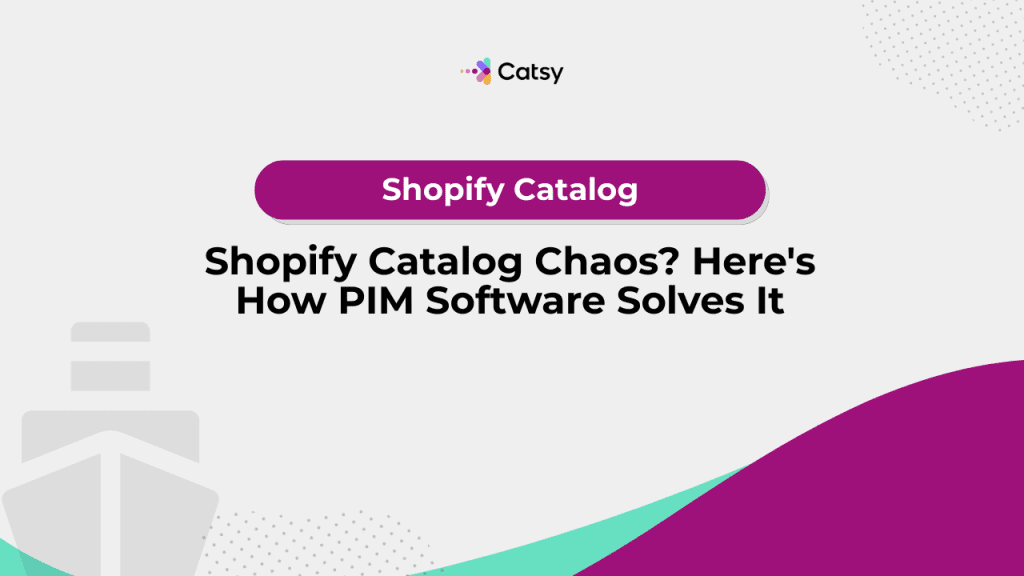Shopify Catalog Chaos? Here's How PIM Software Solves It
Discover real Shopify PIM system examples and case studies. Learn how Catsy helped merchants reduce errors, launch faster, and scale catalog operations globally.

Table of Contents
- Introduction
- Why Case Studies Matter for Shopify Merchants
- Overview: What Makes a Strong PIM System Example
- Case Study 1: SMB Fashion Brand Streamlines Product Launches
- Case Study 2: B2B Electronics Merchant Reduces Errors by 90%
- Case Study 3: Enterprise Multi-Store Retailer Goes Global
- Case Study 4: Home & Garden Brand Accelerates Syndication
- Case Study 5: Supplement Store Boosts Organic Conversions
- Common Themes Across All PIM Success Stories
- Why Catsy is Built for Shopify PIM Retail Success
- Conclusion
What You Will Learn
- Why real-life examples of PIM adoption on Shopify matter to your business
- How Shopify merchants of different sizes and verticals are using PIM systems
- Concrete results like error reduction, time savings, and SEO improvements
- Why Catsy stands out in the competitive sea of PIM providers for Shopify
- How to navigate your own journey from chaos to catalog clarity
In this Article
1. Introduction
Are you running a Shopify store without a PIM system? That’s like navigating choppy waters without a compass. You may have already caught on to the fact that scaling product data means increased risks. Manual errors, channel mismatches, and inconsistent data will quickly sink you.
But with a modern Product Information Management (PIM) for Shopify, you can trim your sails, steer with confidence, and accelerate your growth.
This guide will take you aboard real Shopify journeys. Retailers who used Catsy to centralize their data and syndicate their content will be featured so you can see the true benefits of a PIM.
Let’s explore these real-world PIM system examples that prove how powerful catalog clarity can be.
2. Why Case Studies Matter for Shopify Merchants
a. The Power of Real-World Proof
According to Demand Gen Report, 68 percent of business to business buyers prefer content that demonstrates how a product or service helped others. Case studies show the real world application of PIM and serve as navigational charts for similar buyers.
For Shopify merchants, real examples remove the guesswork:
- Will this PIM work for my catalog size?
- Can it handle multi-store setups?
- What results can I realistically expect?
b. What Merchants Want to Know
Real Shopify merchants want real answers to their immediate questions:
- How much time will I save?
- Will it reduce product listing errors?
- How does this affect my SEO and conversion rates?
In the case studies that follow, we’ll answer all of these questions.
Make Catsy DAM and PIM Software an Extension of Your Team
Book a Free Demo3. Overview: What Makes a Strong PIM System Example
a. Clear Problem-Solution Framing
A good case study will show you:
- The specific catalog challenge a company faced
- How the merchant was operating before implementing PIM
- What changed after implementation of a PIM
b. Quantifiable Outcomes
Examples must include measurable results, including:
- Time saved
- Error reduction
- Conversion increases
- SEO or traffic improvements
c. Relevance to Shopify Store Types
What follows is several hand-picked examples across verticals and business sizes. Whether you’re a nimble direct to consumer seller or a global retailer, there’s a story here that will resonate with you!
4. Case Study 1: SMB Fashion Brand Streamlines Product Launches
Business Type: Shopify-based direct to consumer apparel brand
Catalog Size: Approximately 1,200 SKUs
Pain Point: Manual product launches using Google Sheets and long delays in adding new collections
Challenges:
- Each launch required multiple handoffs between design, marketing, and e-commerce teams
- Inconsistent product tags and descriptions delayed collection filtering
- Frequent errors in sizing and color variants were displayed
Solution with Catsy:
- Created pre-set attribute templates for apparel variants
- Enabled enrichment workflows for design, SEO, and merch teams
- Implemented Shopify metafield syncing
Results:
- 67 percent faster time to launch for new collections
- 0 product attribute errors reported in the first quarter
- 28 percent increase in filtered collection views
“We went from chaotic launches to clockwork coordination. Catsy made our growth scalable.” — Brand Director
5. Case Study 2: B2B Electronics Merchant Reduces Errors by 90%
Business Type: Shopify Plus merchant in electronics distribution
Catalog Size: More than 9,000 SKUs
Pain Point: Inconsistent specs, duplicate SKUs, and high return rates as a result of incorrect tech data
Challenges:
- Technical specs were managed by engineering, uploaded manually
- Sales team was fielding frequent product info complaints
- No clear version control or data validation process
Solution with Catsy:
- Standardized attribute groups for voltage, amperage, and compatibility
- Enforced data validation rules (for instance, no blank fields, unit formatting)
- Enabled internal approval workflow before syndication
Results:
- 90 percent reduction in product data errors
- 35 percent fewer product-related support tickets
- 15% percent drop in product return rates
“We finally have a single source of truth—and our tech specs no longer live in 12 spreadsheets.” — E-commerce Operations Lead
6. Case Study 3: Enterprise Multi-Store Retailer Goes Global
Business Type: Multi-store retailer with localized Shopify sites (US, UK, CA)
Catalog Size: 18,000 SKUs
Pain Point: Difficulties managing regional descriptions, currencies, and compliance data
Challenges:
- Copy/pasting into each Shopify store manually caused errors
- Delayed product updates for global launches
- Local teams lacked visibility into master catalog
Solution with Catsy:
- Used region-specific templates for product titles and descriptions
- Integrated with Shopify Markets and multilingual metafields
- Enabled team permissions by market
Results:
- 100 percent synchronized content across three stores
- 72 percent reduction in launch delay time
- 40 percent increase in speed to market for global campaigns
“Managing multiple Shopify stores from one hub changed the game. Catsy is our global control center.” — Global E-commerce Director
7. Case Study 4: Home & Garden Brand Accelerates Syndication
Business Type: Mid-size Shopify merchant in the home décor category
Catalog Size: Approximately 3,500 SKUs
Pain Point: Slow, manual syndication to Amazon and Walmart
Challenges:
- Different content requirements for each channel
- Frequent data entry errors and listing rejections
- Redundant work in editing titles and images for each platform
Solution with Catsy:
- Channel-specific export templates (Amazon, Walmart)
- Auto-cropping and image resizing for platform requirements
- Real-time product feed syncing with Shopify as the base
Results:
- 75 percent reduction in listing rejection rates
- 50 percent less time spent on product syndication
- Expanded catalog from two to four channels in three months
“Our Shopify catalog is now the helm of a multichannel operation. Catsy gave us that flexibility.” — Channel Marketing Manager
8. Case Study 5: Supplement Store Boosts Organic Conversions
Business Type: Shopify store in health supplements
Catalog Size: Approximately 800 SKUs
Pain Point: Poor SEO performance, low organic conversion rates
Challenges:
- Generic product descriptions
- No alt text or structured metadata
- Duplicate content across variants
Solution with Catsy:
- Bulk-edited descriptions with keyword templates
- Implemented auto-generated alt text for product images
- Structured metafields for Google Rich Snippets
Results:
- 38 percent increase in organic traffic
- 21 percent improvement in organic conversion rate
- Featured snippets won for 12 key product queries
“Our SEO overhaul with Catsy drove real results. This PIM system example speaks for itself.” — Growth Marketing Manager
9. Common Themes Across All PIM Success Stories
a. Centralized Data as the Compass
Each successful implementation of a PIM begins with establishing a centralized, clean source of data. Eliminate your rogue spreadsheets and conflicting versions before you start.
b. Automation as the Wind in the Sails
Automation is your key to success with a PIM. From template-based descriptions to real-time syndication, product information management reduces errors and speeds up your operations.
c. Seamless Shopify Integration as the Rudder
Each of our featured brands used Catsy’s Shopify connector to keep their stores synced and ready to expand. There was no need to reinvent internal workflows.
10. Why Catsy is Built for Shopify PIM Retail Success
- PIM + DAM: Manage product data and digital assets together
- Multichannel Templates: Prebuilt formatting for Shopify, Amazon, Walmart, and more
- Shopify-Specific Features: Support for variants, metafields, markets, alt text
- Role-Based Workflows: Assign merchandisers, copywriters, and marketers to their parts of the journey
- Real-Time Sync: Instant updates from Catsy to your live Shopify store
Brands investing in centralized product content systems report faster time to market and improved customer experiences.
11. Conclusion
There’s no longer a need for Shopify merchants to sail blind. With the right PIM system, you can steer with confidence toward multichannel growth.
The real-world PIM implementation examples in this guide show how Catsy helped brands of all sizes find structure, scalability, and success! Whether you’re drowning in spreadsheets or struggling to scale, Catsy can provide you with the navigational tools you need.
Your next PIM success story starts here.
12. Key Takeaways
- Shopify catalog chaos is a universal challenge across industries
- Real examples show quantifiable benefits of using a PIM system like Catsy
- Merchants save time, reduce errors, and improve SEO and customer experience
- Catsy supports SMBs and enterprise-level Shopify merchants alike
- A centralized PIM retail strategy enables scalable, multichannel growth
Want more tips, tutorials, and insights on product content and e-commerce operations?
Stay connected. We post regularly to help brands like yours scale smarter.
Are You Ready To streamline your product content management?

10. Frequently Asked Questions
A Shopify PIM system example is a real-world scenario where a merchant uses a Product Information Management tool like Catsy to centralize data, automate updates, and improve catalog accuracy across channels.
Yes. Catsy supports Shopify Markets and localized storefronts, enabling region-specific content management and real-time syncing across stores.
Catsy works for DTC, B2B, and multi-channel retailers by offering scalable catalog management, variant support, metafield mapping, and multichannel templates.
Absolutely! Real customers report up to 90% error reduction, 75% faster product launches, and double-digit gains in organic traffic and conversion rates.
Catsy offers Shopify-specific integrations, built-in DAM, real-time syncing, and user-friendly workflows that make it ideal for e-commerce teams without technical complexity.
Subscribe For More Content
Sign up for monthly tips on how to drive revenue with product content.




